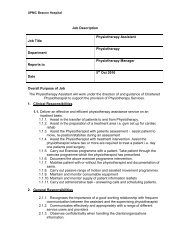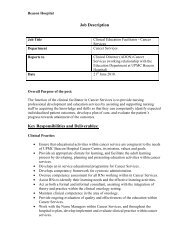here - Beacon Hospital
here - Beacon Hospital
here - Beacon Hospital
Create successful ePaper yourself
Turn your PDF publications into a flip-book with our unique Google optimized e-Paper software.
TITLE: GENERAL GUIDANCE TO<br />
REFERENCE #: PFR.PILS.001<br />
PATIENTS/FAMILY MEMBERS WHO WISH<br />
TO MAKE A COMPLAINT<br />
IMPLEMENTATION DATE: MAY 2013 REVIEW DATE: MAY 2015<br />
GENERAL GUIDANCE TO PATIENTS/FAMILY MEMBERS WHO WISH TO MAKE A<br />
COMPLAINT<br />
How to complain<br />
The most important thing is that you stay safe. If you feel your immediate care may be<br />
compromised by making a complaint or if you feel intimidated in any way by the complaints<br />
process, it may be best to wait until you get some support before making a complaint. An advocate<br />
may be able to help.<br />
The best starting point is usually to make your complaint directly to the person or place<br />
responsible for providing your care. You can do this informally by speaking to the person in charge<br />
of delivering treatment or to a Complaints Officer. You may also wish to complain formally by<br />
putting your complaint in writing. In many cases complaints can be resolved at this stage.<br />
When making a complaint it is best to:<br />
<br />
<br />
<br />
<br />
<br />
Remain calm and polite<br />
Outline clearly what went wrong<br />
Ask for what you need to resolve the situation<br />
Keep notes of what has happened, the contact names of people you’ve talked to and dates<br />
Get support from family, friends or an independent advocate if you feel this would help<br />
1. Checklist for your complaint<br />
Your name<br />
If you writing for someone else, their name and<br />
contact details<br />
Your postal address<br />
Email address and/or telephone number<br />
Summary of the complaint<br />
What happened?<br />
Who was involved?<br />
When did it happen?<br />
W<strong>here</strong> did it happen?<br />
How did it happen?<br />
Page 1 of 5
TITLE: GENERAL GUIDANCE TO<br />
REFERENCE #: PFR.PILS.001<br />
PATIENTS/FAMILY MEMBERS WHO WISH<br />
TO MAKE A COMPLAINT<br />
IMPLEMENTATION DATE: MAY 2013 REVIEW DATE: MAY 2015<br />
Why did it happen?<br />
What is your desired outcome?<br />
Any other information?<br />
2. Complaint Letter Template<br />
Your address 1<br />
Your address 2<br />
Your address 3<br />
Other contact details, eg phone, e-mail<br />
Date<br />
Name of contact person, if available<br />
Company Name<br />
Company address<br />
Re: [service provided]<br />
Dear [Contact Person or Customer Service Manager],<br />
On [date], I [service received] at [location and other details].<br />
I am disappointed because [the service you provided, your service] was [unsatisfactory]<br />
because [state the problem as you understand it giving as much detail as possible].<br />
To resolve the problem I would like you to [state the action you require for example, an<br />
explanation, an apology, the service performed again].<br />
Enclosed is a copy/are copies (of any relevant documents].<br />
I look forward to hearing from you and to a resolution of this problem. Please contact me at the<br />
above address or by phone [give numbers].<br />
Yours sincerely<br />
[Sign]<br />
[Print Your Name]<br />
Enclosures: [state documents you have enclosed , if any]<br />
Cc: [Include Name of person or agency you want to send a copy of this letter to]<br />
Page 2 of 5
TITLE: GENERAL GUIDANCE TO<br />
REFERENCE #: PFR.PILS.001<br />
PATIENTS/FAMILY MEMBERS WHO WISH<br />
TO MAKE A COMPLAINT<br />
IMPLEMENTATION DATE: MAY 2013 REVIEW DATE: MAY 2015<br />
3. Complaints may be submitted in e-mail or writing to:<br />
E-mail: feedback@beaconhospital.ie<br />
Mail:<br />
Patient Safety, Quality and Innovation Department (PSQI)<br />
<strong>Beacon</strong> <strong>Hospital</strong><br />
<strong>Beacon</strong> Court<br />
Sandyford,<br />
Dublin 18<br />
BEACON HOSPITAL’S COMPLAINT REVIEW PROCEDURE<br />
1. Internal review<br />
1. An internal review mechanism is in place for regular evaluation to check that the<br />
complaint process works from both the consumer’s and organisation’s perspectives. The<br />
review and investigation strategies adopted will incorporate incident investigation tools<br />
such as Root Cause Analysis, Critical Incident Review or Clinical Case Review.<br />
2. When complainants will not accept the outcome of the management of the complaint<br />
at the point of contact, a staff member of the Patient Safety, Quality and Innovation<br />
(PSQI) Department will initiate further review.<br />
3. When reviewing a complaint, a Complaint Reference Number is assigned to ensure<br />
that all complaints in the organization are tracked, addressed and properly dealt with.<br />
4. The PSQI reviewer may seek the assistance of the staff members, Departmental<br />
Manager, Clinician or members of the Executive Management Group (EMG) during the<br />
investigation process.<br />
5. Employing incident investigation strategies focuses on reducing systems failure and<br />
managing for its inevitability, whether caused by technology, human error or<br />
procedurally.<br />
6. Investigation and review of complaint must be completed within seven (7) working<br />
days. A response to the complainant is drafted and discussed with the Clinician, CEO or<br />
members of the Executive Management Group as appropriate. The final response is<br />
sent to the complainant within seven (7) working days.<br />
Page 3 of 5
TITLE: GENERAL GUIDANCE TO<br />
REFERENCE #: PFR.PILS.001<br />
PATIENTS/FAMILY MEMBERS WHO WISH<br />
TO MAKE A COMPLAINT<br />
IMPLEMENTATION DATE: MAY 2013 REVIEW DATE: MAY 2015<br />
7. In cases w<strong>here</strong> the agreed time frame will not be possible to complete an<br />
investigation, the PSQI reviewer will keep the complainant informed and updated by<br />
sending progress report every two weeks.<br />
9. As deemed appropriate, the PSQI reviewer, after consultation with CEO, may also<br />
seek an internal review and advice from the Chair of Department or from the hospital’s<br />
legal team especially for difficult cases and critical complaints.<br />
9. Recommendations for preventative and corrective actions are identified from the<br />
review and communicated to the department and staff involved.<br />
2. Independent Review of Complaints<br />
1. The organisation actively encourages and promotes consumer feedback and links with<br />
patients and their families on a regular basis to ensure that the complaint handling processes<br />
are effective, being communicated, and achieving outcomes satisfactory to them.<br />
2. If complainants remain dissatisfied with the outcome of the complaint resolution process<br />
following internal review, complainants will be advised to seek an independent review. For<br />
private patients, an independent review can be sought through:<br />
2.1. Contacting a regulator<br />
Regulators have responsibility for protecting the quality and safety of health and social care<br />
services. Regulators can regulate different things, for example, they can be responsible for<br />
health professionals, health service quality or medicines.<br />
<br />
<br />
<br />
Professional regulators include the Irish Medical Council (IMC), An Bord Altranais (The<br />
Nursing Board), the Pharmaceutical Society of Ireland, the Opticians Board and CORU<br />
(Health and Social Care Professionals Council).<br />
Service quality regulators include the Mental Health Commission, Radiation Protection<br />
Institute of Ireland (RPII) and the Health Information and Quality Authority (HIQA).<br />
Medicines and healthcare product regulators include the Irish Medicines Board and the<br />
Food Safety Authority of Ireland (FSAI).<br />
2.2. Get legal advice<br />
If complaint remains unresolved and complainant feels it is particularly serious, they may wish to<br />
get legal advice on their complaint.<br />
Page 4 of 5
TITLE: GENERAL GUIDANCE TO<br />
REFERENCE #: PFR.PILS.001<br />
PATIENTS/FAMILY MEMBERS WHO WISH<br />
TO MAKE A COMPLAINT<br />
IMPLEMENTATION DATE: MAY 2013 REVIEW DATE: MAY 2015<br />
2.3. Public Patients<br />
When a patient is organised by HSE to be treated at <strong>Beacon</strong> <strong>Hospital</strong> (eg. NTPF patients), the<br />
patient is still considered as a public patient. Public patients have a number of options as to<br />
w<strong>here</strong> to make their complaint. They can complain to the service provider, to the HSE, to the<br />
Ombudsman or the Ombudsman for Children, and to a regulator.<br />
3. Reporting a quality and safety issue/concern to Joint Commission International (JCI)<br />
A patient, staff, or a member of the public may report any safety or quality issue with <strong>Beacon</strong><br />
<strong>Hospital</strong> to its accrediting body, the Joint Commission International.<br />
Complaints may be submitted by e-mail or in writing to:<br />
Email: jciquality@jcrinc.com<br />
Mail:<br />
Quality and Safety Monitoring<br />
Joint Commission International Accreditation<br />
1515 W. 22nd Street, Suite 1300W<br />
Oak Brook, IL 60523 USA<br />
For further information about JCI’s complaint management process, please see:<br />
http://www.jointcommissioninternational.org/Reporting-Quality-and-Safety-Issues/<br />
Page 5 of 5




